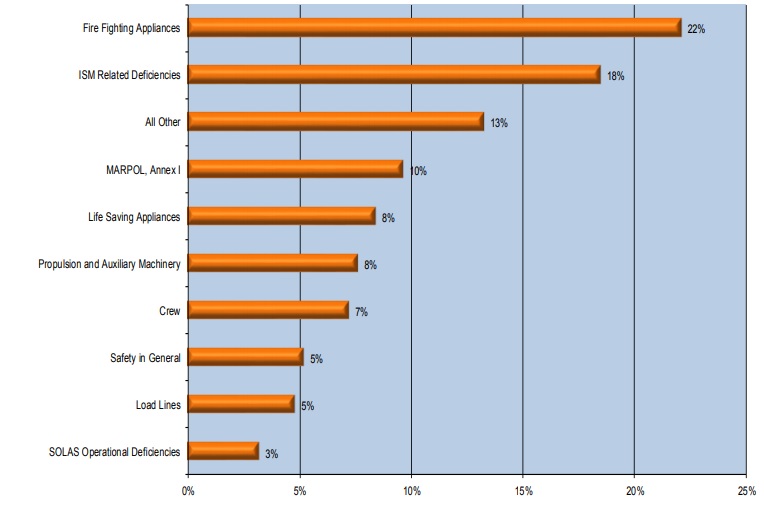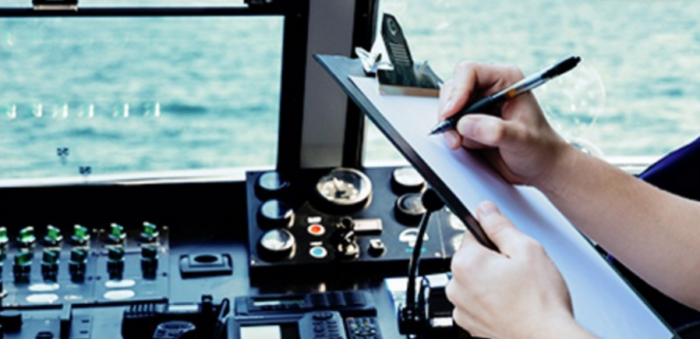The USCG Office of Commercial Vessel Compliance released the US Port State Control Annual Report for 2017, revealing an annual detention rate of 0.99%, the lowest ever in the US. However, the report showed a rise in detentions related to fire fighting, for the fourth straight year. Similarly, MARPOL Annex I deficiencies, which had been on the decline over the past several years, rose slightly in 2017.
Highlights 2017
1. Vessel Arrivals increased – Examinations, Detentions decreased
- In 2017, a total of 10,190 individual vessels, from 84 different flag administrations, made 83,566 port calls to the United States.
- The Coast Guard conducted 9,105 SOLAS safety exams and 8,793 ISPS exams on these vessels.
- These exam numbers decreased slightly from the 2016 totals of 9,390 SOLAS and 8,823 ISPS.
- The total number of ships detained in 2017 for environmental protection and safety related deficiencies decreased from 98 to 91 with the total number of ships detained in 2017 for security related deficiencies decreasing from 8 to 6.
2. Flag Administration Safety and Security Performance
- Flag administration safety performance for 2017 increased, with the overall annual detention rate dropping from 1.05% to 0.99%.
- The three-year rolling detention ratio also decreased from 1.58% to 1.40%.
- The flag administrations of Belize, Samoa, and Taiwan were removed from USCG Targeted Flag List for 2017.
- Flag administration security performance for 2017 increased ever so slightly as well, with the annual Control Action Ratio (CAR) decreasing from 0.09% to 0.06%.
- The three-year rolling average CAR has remained nearly steady dropping from 0.11% to 0.10%.
- Additionally, there are no flag administrations listed on ISPS/MTSA targeted matrix.
3. Detention Appeals
- In 2017, the Coast Guard received a total of 21 detention appeals.
- Eleven appeals were submitted challenging the overall merits of the detention.
- At the time of publication of this report, three appeals were granted and eight were denied.
- For those parties appealing their association with a detention, ten total were received.
- Of those ten, two were denied and eight were granted.
4. QUALSHIP 21 and E-Zero Programs
- The QUALSHIP 21 (QS21) program ended calendar year 2017 with an enrollment of 2,013 vessels.
- For 2016, USCG had only one flag administration lose its QS21 eligibility over the previous year.
- Even with the slight drop in detentions in 2017, four flag administrations lost their eligibility while two additional flags became eligible.
- France and the Netherlands became QS21 eligible this year.

[smlsubform prepend=”GET THE SAFETY4SEA IN YOUR INBOX!” showname=false emailtxt=”” emailholder=”Enter your email address” showsubmit=true submittxt=”Submit” jsthanks=false thankyou=”Thank you for subscribing to our mailing list”]
Overview of detainable deficiencies 2017
In 2017, USCG witnessed a decrease in the number of detentions from the previous year. Below are some common themes repeated for detainable deficiencies found during USCG PSC examinations:
- Fire Protection Systems: Detentions related to fire detection continue to be of concern. During one exam, over 30 inoperable smoke detectors were discovered that encompassed the entire engine room. There were several instances of required remoteoperable fuel shutoff valves on various fuel and lube oil tanks disabled in the open position. Despite being certified by a servicing technician and having also undergone a class survey, a fixed CO2 system was discovered completely disconnected between the time delays and the CO2 bottles. Detentions related to compromised fire doors, no water flow to deck spray nozzles, and empty fire extinguishers, were also at the list.
- Safety Management Systems (SMS): The number of SMS related deficiencies continues to remain consistent over the last several years. Instances of multiple uncorrected material deficiencies indicating a failure to implement a ship’s SMS were most common. Several SMS related detentions also resulted from the failure of the master and or crew to report nonconformities to the company in accordance with their approved SMS. Additionally, expanded ISM exams turned up many examples of maintenance logs not accurately reflecting the actual substandard condition of lifesaving and firefighting equipment. In these cases, the ship was not only detained, but an external audit of the SMS was recommended.
- Lifesaving Equipment: Detainable deficiencies related to lifesaving equipment declined significantly over last year. However, deficiencies related to rescue boats and their state of readiness were most frequently observed. There were also instances of lifejackets being found deteriorated to such an extent that they would not maintain floatation.
- MARPOL Annex I: MARPOL Annex I deficiencies increased slightly this year. Even with this slight increase, the numbers are still relatively low compared to past years. At one time, these types of deficiencies made up nearly one quarter of all detainable deficiencies issued with inoperable oily water separating (OWS) equipment dominating this category. For 2017, only 11% of USCG detentions were MARPOL Annex I related.
- Safety in General: This topic can cover almost any area throughout a ship and if not addressed immediately can lead to serious injury or loss of life. During an exam on a tank ship, PSCOs discovered all explosion proof deck lights in the cargo area were compromised. Other detentions resulted from fuel leaks in various systems and in one case a propeller shaft was found leaking at a rate of over ten gallons per minute.

Further details may be found herebelow:



































































